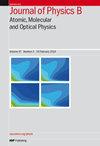The Faddeev and Schrödinger approaches to Efimov states—a numerical comparison
IF 1.5
4区 物理与天体物理
Q3 OPTICS
Journal of Physics B: Atomic, Molecular and Optical Physics
Pub Date : 2023-09-08
DOI:10.1088/1361-6455/acf820
引用次数: 0
Abstract
We compare effective hyperradial three-body potentials calculated using the S-wave part of the Faddeev equations to calculations using the full Schrödinger equation. As two-body model potential we test both a short-range potential and a Lennard-Jones potential with van der Waals tail. In the former case we find excellent agreement between the two methods for the lowest adiabatic state, indicating that the Faddeev method can be a useful tool also for numerical computations. For excited states the two methods show important differences, but agree for hyperradii larger than about five times the range of the potential (independent of the value of the scattering length and of the number of bound states). For the van der Waals potential, we focus on how well the Faddeev method reproduces the so-called van der Waals universality. We find that indeed the universality is manifest also using this method, but at a slightly different value of the universal parameter κ∗ . We further derive an efficient method to solve the integro-differential equation arising in the Faddeev method.Faddeev和Schrödinger对Efimov状态的方法——数值比较
我们比较了使用Faddeev方程的S波部分计算的有效超径向三体势与使用全薛定谔方程计算的超径向三体势能。作为两体模型势,我们测试了短距离势和范德华尾巴的Lennard-Jones势。在前一种情况下,我们发现两种方法在最低绝热状态下非常一致,这表明Faddeev方法也是一种有用的数值计算工具。对于激发态,这两种方法显示出重要的差异,但对于大于电势范围约五倍的超半径(与散射长度的值和束缚态的数量无关),它们是一致的。对于范德华势,我们关注的是Faddeev方法在多大程度上再现了所谓的范德华普适性。我们发现,使用这种方法确实可以看出普遍性,但普遍性参数κ*的值略有不同。我们进一步推导了一种求解Faddeev方法中积分微分方程的有效方法。
本文章由计算机程序翻译,如有差异,请以英文原文为准。
求助全文
约1分钟内获得全文
求助全文
来源期刊
CiteScore
3.60
自引率
6.20%
发文量
182
审稿时长
2.8 months
期刊介绍:
Published twice-monthly (24 issues per year), Journal of Physics B: Atomic, Molecular and Optical Physics covers the study of atoms, ions, molecules and clusters, and their structure and interactions with particles, photons or fields. The journal also publishes articles dealing with those aspects of spectroscopy, quantum optics and non-linear optics, laser physics, astrophysics, plasma physics, chemical physics, optical cooling and trapping and other investigations where the objects of study are the elementary atomic, ionic or molecular properties of processes.

 求助内容:
求助内容: 应助结果提醒方式:
应助结果提醒方式:


